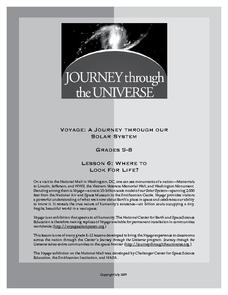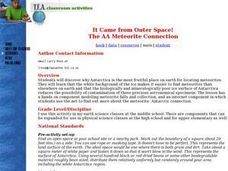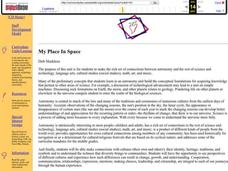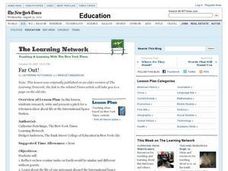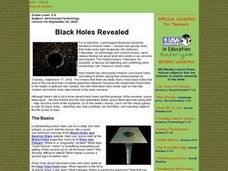NOAA
Ocean Primary Production
A cold seep is an area on the ocean floor where hydrocarbons leak from the earth, creating entire unique biomes. Learners explore cold seeps, photosynthesis in the ocean, and its limitations due to loss of sunlight. They further explore...
NASA
Christa's Lost Lesson: Effervescence
How are chemical reactions affected by gravity? Learners explore the phenomenon of effervescence as part of the Christa's Lost Lessons series. They compare findings in an experiment on effervescence to a video of a similar experiment in...
Journey Through the Universe
Where to Look For Life?
Every year we discover new planets including more than 1,000 in 2016 alone. Will we ever find life on another planet? The lesson includes two activities to help scholars understand this concept. First, they analyze the temperature range...
Journey Through the Universe
Is There Anyone Out There?
What is an alien's favorite game? All-star baseball! Scholars start defining living and non-living. Then, they conduct experiments to research if life exists, keeping in mind that life could be in many forms, not just human.
US Environmental Protection Agency
Sea Level: On the Rise
With the global temperature on the rise, the effects of climate change are starting to be seen. However, many people have a difficult time conceptualizing the long-term effects, such as sea levels rising. Given an easy and effective...
Curated OER
Apollo Moon Landing
Students explore paper rockets, learn about the Apollo Program and Apollo spin-offs, and use simple office supplies to design and create a new useful product. This amazing plan is incredibly well written and leads students through a...
Curated OER
It Came from Outer Space! The AA Meteorite Connection
Students discover why Antarctica is the most fruitful place on earth for locating meteorites. They work in groups. Students are given a Museum or University Name for each group. They are explained that each group is allowed to comb...
Curated OER
A Model of Earth's Atmosphere
Students make a model of the four layers of Earth's atmosphere that represents the characteristics of each layer.
Curated OER
How Does Flowing Water Shape a Planet's Surface?
Students investigate how flowing water influence landforms. In this earth science lesson, students observe water behavior as it flows from the stream table at various inclinations. They discuss whether water shaped Mars landforms or not.
Curated OER
Problems With Space Exploration-Reading Comprehension
In this reading comprehension worksheet, students read a passage about problems with space exploration, then complete a set of comprehension activities, including writing 2 paragraphs about a given topic.
Curated OER
Hubble Space Telescope Webquest
Students research the Hubble Space Telescope. In this Hubble Space Telescope instructional activity, students complete a webquest about the Hubble Space Telescope.
Curated OER
My Place In Space
The purpose of this unit is for students to make the rich set of connections between astronomy and the rest of science and technology, language arts, cultural studies (social studies), math, art, and music.
Curated OER
The Great Hubble
Learners explain how Hubble telescope captures images from space. In this space science lesson, students use the internet to view space photos. They debate on an issue raised by the teacher.
Curated OER
Swinging on a Star
Students explore the issues that might arise if humans were to go on an interstellar space mission. They synthesize their understanding of interstellar travel by writing scenes from a science fiction novel that would depict such a mission.
Curated OER
The Earth Around Us: Air, Water & Soil
Students build an air cannon and study air mass. In this air cannon lesson, students create and shoot an air cannon and observe what happens. Students answer critical thinking questions about air mass and air cannons.
Curated OER
Far Out!
Students research and compare/contrast how routine tasks on Earth would be without gravity. They read and discuss the article "The Life Galactic: A Lot of Work, a Little Play, Plenty of E-Mail." In groups they write a pitch for a TV...
Curated OER
TE Activity: Northward Ho!
Students design a simple compass. They examine how the Earth's magnetic field has both horizontal and vertical components. They determine how a compass works and work with cardinal directions.
Curated OER
Chesapeake Scramble
In this environmental science learning exercise, students identify the different animals that live and visit Chesapeake Bay by completing 6 word scrambles.
Curated OER
Black Holes Revealed
Students explore the concept of black holes through an interactive program. They explore how they form and what materials form them. They can also visit websites in which they can research radio transmission between the Earth and space.
Curated OER
Earth Energy Budget Pre Lab
Learners explore energy by conducting an in class experiment. In this climate change instructional activity, students conduct a water vapor experiment in a soda bottle. Learners utilize graphs and charts to analyze the results of the...
Curated OER
The Making of a Star
Students create schematic diagrams of the new Russian space station module. They compose an imaginary yet realistic series of diary entries from the point of view of an astronaut living on board the completed space station.
Curated OER
Early Space Missions
In this space missions instructional activity, learners read about the launch of the space shuttle Magellan and its exploration of Venus. Students complete 2 short answer questions based on the reading.
Curated OER
Space Exploration - Boom or Bust?
In this space exploration learning exercise, students will label if 5 statements support space exploration or not. Then students will complete 2 short answer questions giving their opinion about three things that are good and three...
Curated OER
Space Travel Brochure
Students discover information about the planets and the solar system. They work together to research a specific planet. They develop a brochure for the planet and share with the class.


